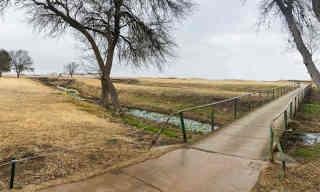During the heat of summer, when upland pastures swelter, the shade, forage and water in wooded draws and gallery forests along larger streams provide animals with refuge from the heat and sun. In the winter, they provide shelter from blowing wind and snow. Some producers prefer pastures with wooded riparian areas for calving, as the shelter they provide can reduce stress on both the cow and the newborn calf. These direct benefits are crucial for many livestock operations.
Riparian areas also have a multitude of indirect benefits for livestock producers. They serve as sponges when water is available, soaking it up, and then slowly releasing it as the season goes on. The storage and delayed release of water helps to slow water down, which can lessen flooding downstream and allows excess nutrients and pollution to settle out of the stream, making it safer for livestock to drink. The slowing of water also lengthens the duration of stream flows and provides water for vegetation long after the uplands have become dry. The thick line of vegetation that grows along the banks of a healthy stream serves as a filter, catching soil and excess nutrients before it can wash into the stream, decreasing erosion and improving water quality.
Wildlife is also attracted to riparian areas. Deer, pronghorn, pheasants, ducks and many other wildlife species are reliant on them, with 75 to 80% of wildlife in some areas using riparian areas at some point during their lives (Chaney et al., 1990; Thomas et al., 1979). Even species that are more often associated with upland areas rely heavily on riparian areas to feed and shelter their young until they can survive the uplands. This abundance of wildlife can be important for producers, either as a personal resource for enjoyment with family and friends, or as a potential source of diversified income through ecotourism and hunting leases.
Challenges Facing Riparian Areas

Despite their importance to livestock, many riparian areas in the western United States and around the world have become degraded. Courtesy: U.S. Department of Agriculture
Despite their importance to livestock, many riparian areas in the western United States and around the world have become degraded. Altered flows and heavy runoff from historical overuse have caused many streams to dig themselves so deeply into the streambed that the roots of streamside plants can no longer reach water for much of the year, and instead of providing water to riparian areas, these streams now serve to remove it from the land. Over half the streams in the Northern Plains Region have significantly decreased or altered plant communities, and most are considered to be impaired to some extent (U.S. Environmental Protection Agency, 2006). For many producers, riparian pastures are essential to their operation. However, land managers need to balance grazing and utilization needs with riparian health for the long-term benefit of their operation.
Repair and Restoration Efforts
Efforts to slow or repair the damage done to riparian areas are becoming more common with each passing year. Each stream and ranch are different, but there are an increasing number of management options to improve riparian areas. Changing grazing strategies, temporary or long-term exclusion of grazing, off-stream watering, improvements to water infrastructure, stream restorations, and other strategies, such as low-cost, low-tech restoration practices, can be balanced with producer needs and have been used successfully to repair or restore riparian areas.
Source : sdstate.edu